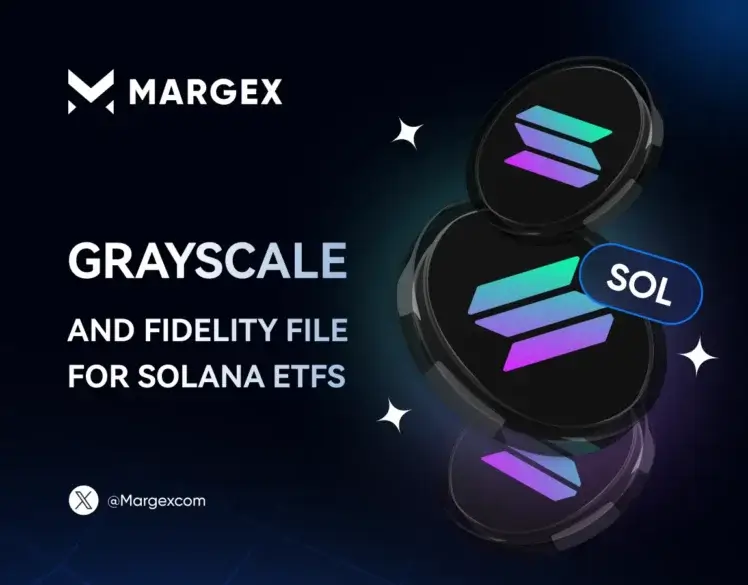Grayscale and Fidelity File for Solana ETFs, But SOL Price Drops Hard

Grayscale Investments has taken a radical step by filing a registration form for registering a spot Solana ETF, following the example of several other fund managers. Just before this move, in late March, Fidelity Investments also took this significant step. Grayscale plans to convert its Solana Trust into a spot ETF like it converted its Bitcoin and Ethereum Trusts last year.
Fidelity registered the “Fidelity Solana Fund” with the CSC Delaware Trust Company and filed for a spot ETF based on Solana that will be trading on the CBOE exchange on March 25.
SEC acknowledges Fidelity’s SOL ETF filing
These ETP products that the investment giants have filed for will offer indirect exposure to SOL to investors – they will not have to hold actual SOL coins but just buy ETF shares sold by the companies. However, it will be Grayscale and Fidelity who will have to hold a large amount of SOL to back the ETF shares they will be offering to investors. This potentially raises the odds of decreasing the circulating supply of the coin and, in theory, can help give the SOL price a major boost.
At the end of last week, the US Securities and Exchange Commission (SEC) acknowledged Fidelity’s filing for a Solana ETF. However, instead of surging amid the positive news about those ETF filings, SOL ETF reacted with a sharp decline in light of the recent economic turmoil caused by trade tariffs imposed on the world by US president Donald Trump.
Brief history of Solana’s emergence
The concept of Solana was created by software engineer Anatoly Yakovenko in 2017. He came up with the idea of an innovative Proof-of-History (PoH) consensus protocol to strengthen the stability of this blockchain and also to enhance the transaction speed on it. Traditional blockchains, such as Bitcoin and Ethereum, often face issues due to various inefficiencies arising in the process of using the Proof-of-Work system (when Solana was created, Ethereum still ran on PoW). Unlike PoW, the Proof-of-History system creates a historical record that proves events’ occurrence at particular time stamps. This efficiently works as a cryptographic clock for the network and allows Solana to process transactions simultaneously, thus giving its throughput a significant boost.
In combination with major updates implemented by Solana – Tower BFT, Turbine, and Seavel – Solana performance metrics have demonstrated remarkable growth. The official Solana mainnet was launched in 2020, attracting developers and users with its capability to process thousands of transactions per second and positioning itself as a powerful competitor to Ethereum, calling itself yet another “Ethereum Killer.”
Bitcoin ETF launched; SOL ETF filing follows
The approval of spot Bitcoin and then Ethereum ETFs in January and June last year by the SEC marked the achievement of crucial milestones for crypto as it became one step deeper integrated into traditional financial markets.
These ETFs allowed investors to own crypto by just buying shares without having to manage the difficulties of using digital wallets for holding crypto. The Bitcoin ETF was finally approved after many months of waiting, and both Fidelity and Grayscale were among the first to file for those, along with the BlackRock giant. The approval of Bitcoin and Ethereum funds caused these fund managers to begin accumulating BTC and ETH on a large scale, making huge daily purchases because they need crypto to back their ETF shares. Besides, the Bitcoin price saw a significant boost after this approval and after the fourth halving that followed it and occurred on April 20, 2024.
Now, that ETFs have been approved for the two leading cryptos, the same companies have filed for XRP and DOGE ETFs, and now the time has come to file in official requests for the SEC to approve a Solana spot ETF, as fund managers are seeing a great demand in this product in the market.
SOL price down amid Trump’s tariffs integration
However, the positive news about the ETF filings did not help Solana’s price to increase. Since Friday, SOL has faced a decline of almost 9% as it fell from $123.3 to $112.5. Previously, during the last week, SOL crashed by roughly 13%, falling from the local high of $131.
The sharp decline took place due to multiple factors. However, one of the major ones was the reaction of the crypto market to the new round of trade tariffs imposed by Donald Trump on 180 countries except Russia and Belarus. Currently, the governments of several countries are negotiating with Trump and are discussing the potential lifting of those draconian tariffs on all goods imported to the US.
While the stock markets and altcoins are bleeding, Bitcoin remains more or less resilient, holding above the $80,000 level. Still, this weekend, BTC has also experienced a 3% decline.


